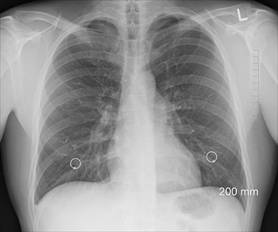Emphysema Frequently Found During Cancer Screening
 Emphysema detected with lung-density analysis software during low-dose CT lung cancer screening can be highly predictive of lung cancer risk, new research shows.
Emphysema detected with lung-density analysis software during low-dose CT lung cancer screening can be highly predictive of lung cancer risk, new research shows.
“Almost everyone has an incidental finding,” said investigator Humberto Choi, MD, from the Cleveland Clinic, noting that coronary artery disease, renal cell carcinoma and arthritis are all commonly found. “But emphysema is the one we’re concerned about.”
The prevalence is about 60 percent, but because “we don’t know the threshold at which we should act on the emphysema,” it is not clear how to proceed when it is detected, Choi told Medscape Medical News.
No protocol or care path exists, which is important because screening results that fall into categories that indicate higher risk for malignancy are associated with a higher incidence of cancer. Too, more severe emphysema tends to be detected in these patients.
Emphysema was detected in 125 (39 percent) of the 321 participants screened, indicated by a score that was greater than 0 percent. In the study cohort, 101 (31 percent) participants had previously been diagnosed with chronic obstructive pulmonary disease (COPD).
During the 12-month follow-up period, patients with emphysema detected made significantly more pulmonary outpatient visits than patients without emphysema (43 percent vs. 27 percent). The rate of visits to the emergency department was similar both groups (35 percent vs. 29 percent), as was the rate of hospitalization (7 percent vs. 12 percent).
“Patients with emphysema detected had more outpatient visits and more need for inhalers,” Choi said, adding that follow-up and treatment protocols are needed. “We need to better understand which patients should see a pulmonologist and be treated.”
Emphysema also was associated with a higher incidence of lung nodules in a separate study presented at the meeting by the same team. Their analysis of 314 patients from the same Cleveland Clinic cohort assessed Lung-RADS assessment categories. Five patients were diagnosed with lung cancer during the four-year follow-up period.
“The emphysema itself causes benign risk nodules to look different, more irregular,” Choi said.

